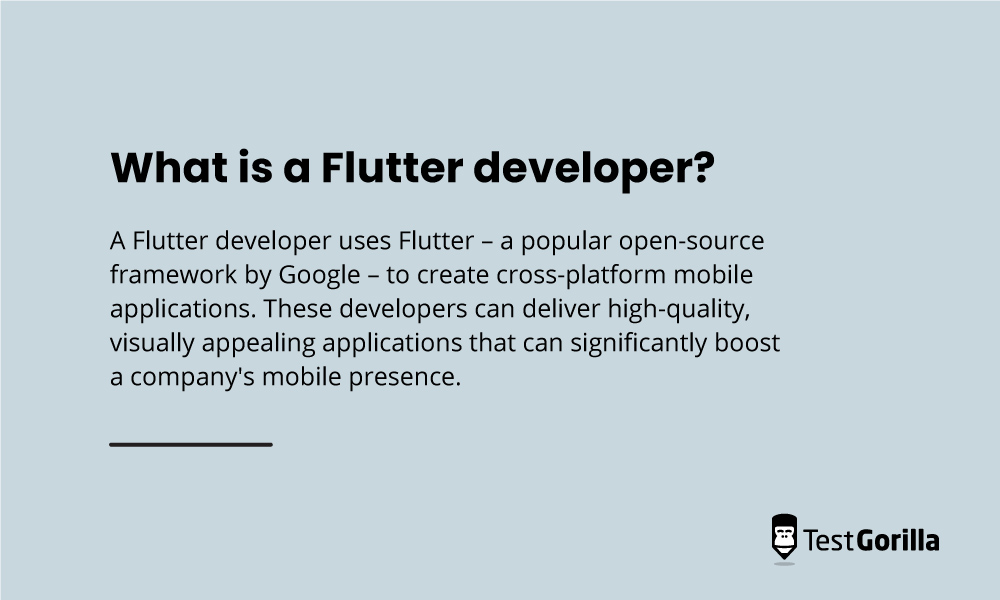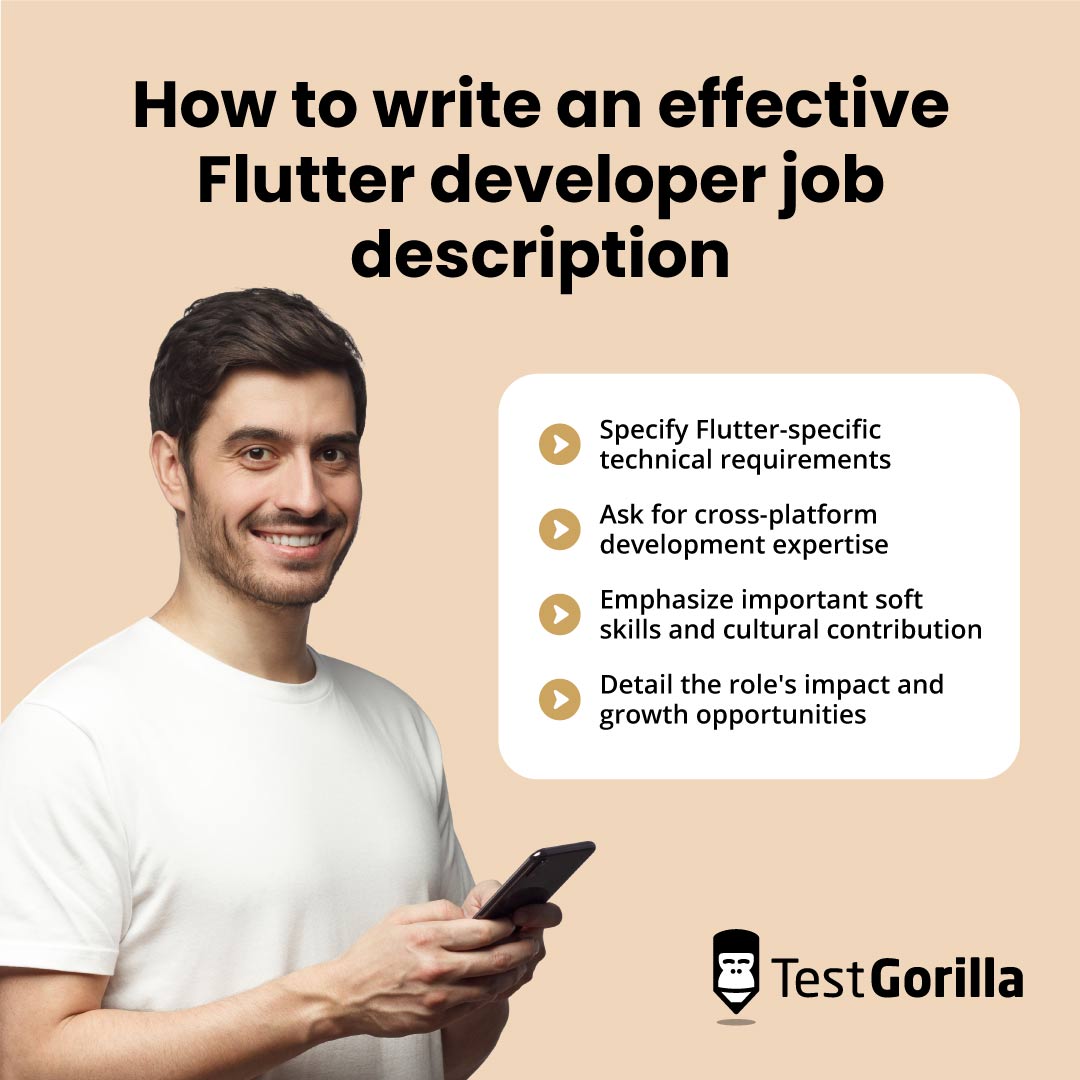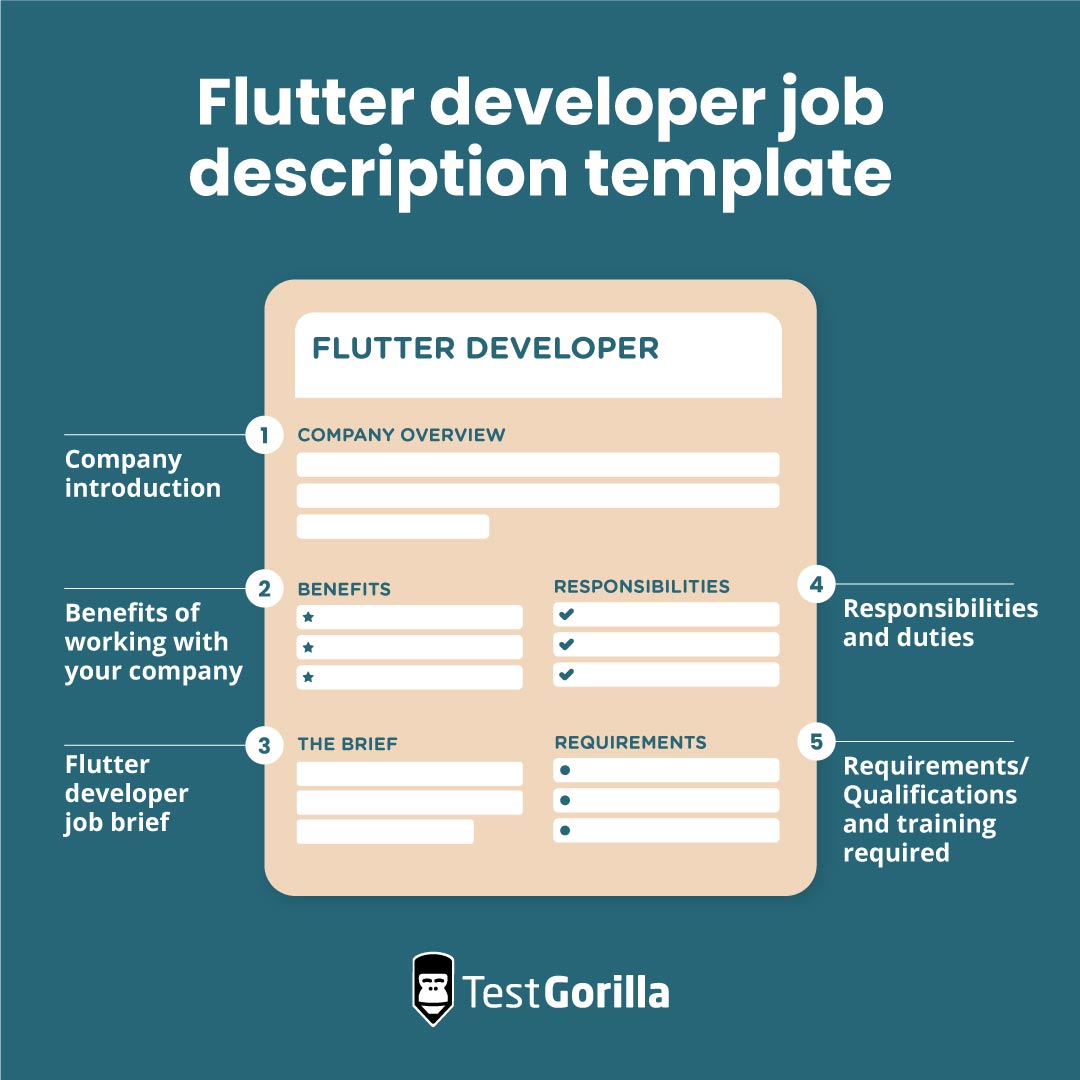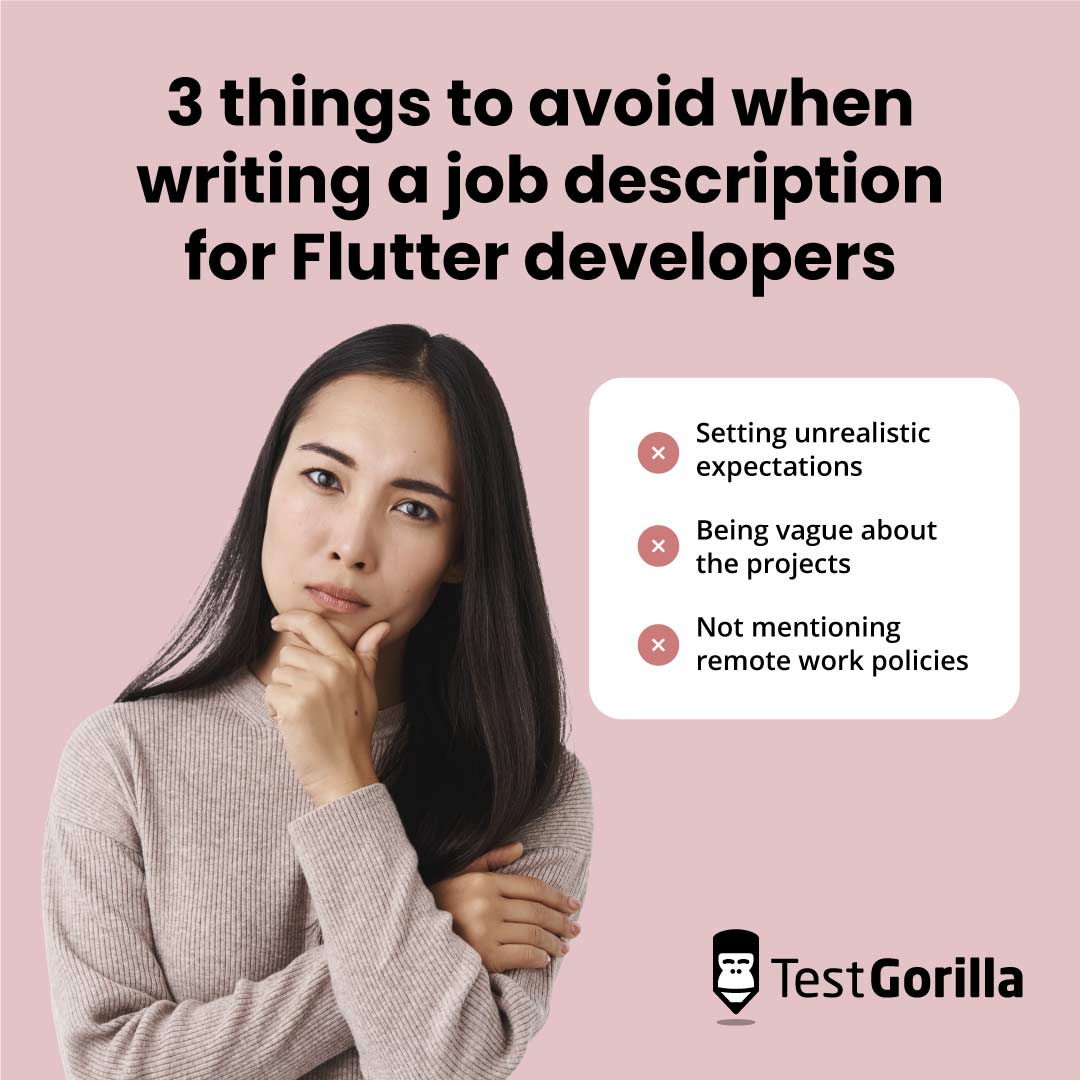A skilled Flutter developer can create apps with a smooth user experience and captivating design, greatly enhancing customer engagement. On the flip side, hiring the wrong person can lead to apps that are buggy, unattractive, or unable to function correctly across different devices – causing frustration for users and potentially damaging your brand's reputation.
Hiring the right person begins with a well-crafted job description. It spells out the technical expertise needed while emphasizing the need for the developer to mesh with your team's work style.
This guide teaches you to write a job description that draws in the very best Flutter talent. We also provide a template to get you started.
Table of contents
- What is a Flutter developer?
- Key skills to look for in a Flutter developer
- How to write an effective Flutter developer job description
- Flutter developer job description template
- 3 things to avoid when writing a job description for a flutter developer
- Next steps: Attracting and assessing Flutter developer candidates
- FAQs
- Hire top Flutter developers with TestGorilla
What is a Flutter developer?
A Flutter developer uses Flutter – a popular open-source framework by Google – to create cross-platform mobile applications. These developers can deliver high-quality, visually appealing applications that can significantly boost a company's mobile presence.
These apps use a single codebase to provide an intuitive experience on Android and iOS devices. This approach can maximize your reach with minimal development time and cost.
Key skills to look for in a Flutter developer
When hiring a Flutter developer, look for skills that directly contribute to creating successful mobile applications:
Proficiency in Dart: Dart is the primary programming language for creating Flutter apps. Want to assess a candidate’s competency with Dart? Check out our tricky Dart developer interview questions.
Understanding of the Flutter framework: A developer who knows this framework inside out can craft user-friendly, attractive interfaces.
Experience with cross-platform development: The developer should make the app work smoothly on iPhones and Android phones.
Knowledge of RESTful APIs and web services: REST APIs are like bridges between your app and the internet. A developer with this knowledge can connect your app to online services and data.
Attention to UI/UX principles: Design thinking skills focused on user interface and user experience ensure the app is good-looking and easy to use.
Effective communication skills: Developers need these to understand project requirements and collaborate with team members.
Adaptability and problem-solving: The developer should be able to handle unexpected challenges and adapt to evolving project needs.
The best insights on HR and recruitment, delivered to your inbox.
Biweekly updates. No spam. Unsubscribe any time.
How to write an effective Flutter developer job description
A strong job description should focus on skills and “sell” the role to candidates. This will draw in the right ones and convince them to apply. Follow these steps.
Specify Flutter-specific technical requirements
List specific technical skills relevant to Flutter development. These can include proficiency in Dart, understanding of state management solutions in Flutter, and experience with Flutter widgets.
Ask for cross-platform development expertise
Your job description should emphasize the need to develop apps that work seamlessly across iOS and Android. This will draw in candidates with relevant skills who understand the nuances of adapting applications to different platforms.
Emphasize important soft skills and cultural contribution
Mention the importance of soft skills like teamwork, communication, and problem-solving. Flutter projects often require collaboration, so finding a developer who can work well in your team's environment is essential. Highlight your company culture and the interpersonal skills that would make your new hire a strong contributor to that culture.
Detail the role's impact and growth opportunities
Describe how a Flutter developer impacts your company's products and services. Explain any unique opportunities for growth within the role. This gives potential candidates a clear idea of their career trajectory and showcases your company as one that invests in its employees' professional development.
Flutter developer job description template
Instead of starting from scratch, use our template – just fill it in and tailor it to your company’s needs.
Company introduction
Emphasize your company's focus on innovation and technology, particularly in mobile app development.
Mention any notable projects or achievements in mobile app development your company has accomplished. This will attract Flutter developers who are excited about pushing boundaries in app development and are eager to contribute to groundbreaking projects.
Benefits of working with [your company]
Detail the benefits that appeal to Flutter developers – like opportunities to work on diverse and challenging projects, a culture of continuous learning, and a collaborative environment.
Emphasize any unique perks your company offers, like flexible working hours, remote work options, or state-of-the-art technology resources, as Flutter developers often highly value these.
Flutter developer job brief
[Company Name]
Job Title: [For example, Flutter Mobile Developer or Senior Flutter Developer]
Reports to: [For example, Head of Mobile Development or CTO]
Position type: [Full-time, part-time, on-site, remote, or hybrid]
[Compensation details]
Flutter developer responsibilities
Design and build high-performance, scalable mobile applications using Flutter.
Ensure robust and effective cross-platform functionality on both Android and iOS.
Collaborate and communicate effectively with cross-functional teams to define, design, and ship new features.
Maintain and improve code quality, organization, and automatization.
Stay updated with and adapt to the latest trends in Flutter development.
Work closely with the UI/UX team to ensure aesthetic and functional designs.
Troubleshoot and solve problems in application performance and functionality.
[Additional responsibilities as per your company’s requirements]
Flutter developer requirements/qualifications and training required
Bachelor’s/Master’s degree in information technology, computer science, or a related field (or equivalent training/experience)
Strong knowledge of Dart and Flutter framework
Experience with Flutter widget creation, state management, and animations
Proficiency in cross-platform mobile development and understanding platform-specific nuances
Familiarity with REST APIs and mobile backend integration
Experience with version control tools (e.g., Git)
3 things to avoid when writing a job description for a flutter developer
When drafting a job description for a Flutter developer, avoid these common mistakes:
1. Setting unrealistic expectations
Honesty and clarity help align candidate expectations with the job's realities, but you shouldn’t overwhelm candidates with a long list of responsibilities – especially if some fall outside the role’s scope. Some Flutter developer job descriptions do this to cover all bases, but it can drive away candidates. So, prioritize the essential tasks your developer will perform regularly to help candidates understand the role’s true nature.
Still, if the role genuinely involves a long list of responsibilities – including front-end, back-end development, or project management – be upfront about it.
2. Being vague about the projects
Instead of just stating “Flutter development,” specify the types of projects your Flutter developer will work on, such as e-commerce apps, enterprise-level applications, or innovative tech startups. This clarity can attract those passionate about these specific areas.
3. Not mentioning remote work policies
Flutter's growth shows no signs of slowing. As the demand for Flutter developers grows, they can be more selective about the jobs they choose to do.
So, clarify your company's stance on remote or hybrid work. It can be a deciding factor for many candidates, especially sinceremote work is often feasible and desired in the tech industry.
Next steps: Attracting and assessing Flutter developer candidates
Once you've posted your job description on sites like LinkedIn and UpWork, you'll need to evaluate interested applicants. Every Flutter development role differs, so a one-size-fits-all evaluation doesn't make sense.
TestGorilla provides a flexible solution with its pre-employment testing platform, offering scientifically backed tests to assess various skills and traits. With TestGorilla, you can streamline your hiring process and improve the chances of finding the ideal candidate for your specific needs.
TestGorilla has more than 300 tests, including technical skills assessments. Tests that can help you assess Flutter candidates effectively include:
Additionally, consider assessing the personality of your candidates by adding in behavioral tests, such as our:
After testing all your candidates, you can move to the interview stage. For more insights, read our article on52 great questions for a Flutter developer interview.
FAQs
Is Flutter development more of a front-end or back-end skill?
Flutter development is primarily a front-end skill. It focuses on building user interfaces and user experiences for mobile apps.
What coding languages are relevant for a Flutter job description?
The most relevant coding language in a Flutter job description is Dart. Knowledge of additional languages like JavaScript, Java for Android, and Swift for iOS can be beneficial but is secondary to Dart expertise.
Hire top Flutter developers with TestGorilla
You now have the tools to craft a great Flutter developer job description. Be sure to detail both technical and soft skills while clarifying role expectations.
TestGorilla simplifies the next phase of your hiring process. Our platform gives you access to specialized Flutter tests, UX/UI design assessments, and Android development tests. These, along with our behavioral and cognitive ability tests, ensure you find a candidate with the right technical skills and working style to make all your mobile projects successful.
Take a quick product tour to learn how TestGorilla can streamline your hiring process and secure the best Flutter talent. You can also sign up for a free TestGorilla account and start optimizing your recruitment today.
You've scrolled this far
Why not try TestGorilla for free, and see what happens when you put skills first.






















